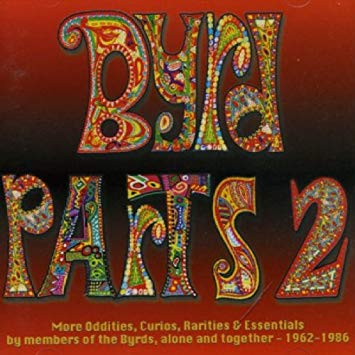Peter Fonda died last summer, and most of the remembrances properly focused on his acting career. For a while, however, he had about as interesting a role in rock music as anyone outside of the music business did. And he was briefly part of the music business, recording a 1967 single that hardly anyone heard.
Much of Fonda’s interaction with the rock world was with or related to the Byrds. Something that distinguished the Byrds from most, or maybe all, rock groups that preceded them was their avid following among Hollywood hipsters. Jack Nicholson (a few years away from becoming a star) and Sal Mineo were among the celebrities who were dancing to the Byrds at Ciro’s on Sunset Strip before the group even had a hit record. And Peter Fonda was responsible for getting the Byrds to play at Jane Fonda’s Malibu party on July 4, 1965, a week after “Mr. Tambourine Man” had topped the charts.
Also at the party were Henry Fonda, Steve McQueen, Diahann Carroll, Roddy McDowell, Mia Farrow, Warren Beatty, Peter Finch, James Fox, Dennis Hopper, David McCallum, Sidney Poitier, Roger Vadim, Gene Kelly, and Lauren Bacall—hardly your ordinary rock gig guest list, even for a private Hollywood affair. Wrote Johnny Rogan in his huge biography Byrds: Requiem for the Timeless Volume 1, “At one point, Henry Fonda questioned why the Byrds had to play so loudly, but otherwise he seemed unfazed by his children’s new friends.”
Here’s how Peter remembered it in his memoir Don’t Tell Dad: “‘Can’t you get them to turn it down?’ my father, who was standing right beside me, yelled with his hands cupped around his mouth. Of course I couldn’t.”
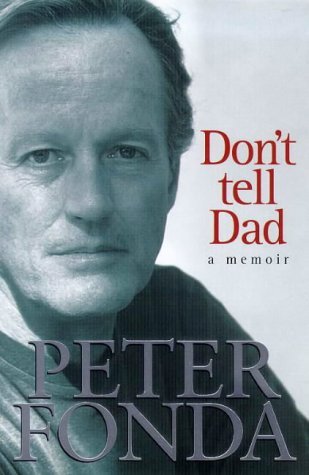
Yet Fonda remains most famous—or infamous—in the rock world for a passing comment he made to a member of an even more famous rock band the following month. When the Beatles came to Los Angeles during their summer 1965 tour, Fonda went over to the Benedict Canyon house where they were staying. David Crosby was there too, and gave Peter a dose of LSD. All of the Beatles except Paul McCartney were tripping as well. Here’s how Fonda tells it in Don’t Tell Dad:
“George [Harrison] was having a rough time. Apparently, he had been dosed before without knowing it and had a hellish experience. He said that he thought he was dying. I tried to calm him and let him understand that it was his own brain putting fear in his thoughts and trying to keep a control on the uncontrollable, just as impossible a task as controlling dying. I told George that I knew what it was like to be dead, and that everything would be all right. He wasn’t so sure, understandably, and as I was telling him the story of my own death on the operating table [Fonda had nearly died there as a youngster], John Lennon came over to where we were seated.
“‘Who put all that crap in your head?’ he asked angrily. ‘You’re making me feel like I’ve never been born!’
“This was how the song ‘She Said She Said’ came to life. John didn’t like the role he’d assigned me—Trip Guide. We watched Jane’s Cat Ballou that evening, too, and John had had enough of Fondas. Roger McGuinn—in those days known as Jim McGuinn—worked hard and fast to make things smooth. With Paul [McCartney]’s help he got John to forget the incident and go on with the trip. We ended up in a sunken tub in the master bathroom —no water—while everyone played and sang. McGuinn and Harrison played their electric twelve-strings with no amplification, but the hard surfaces of the bath acted as a booster for the sound. George played some Bach riffs that blew my mind.”
Five years later, Lennon remembered the incident vividly, and a little bitterly. “He kept saying [in a whisper] ‘I know what it’s like to be dead,’ and we said ‘What?’ and he kept saying it,’” he told Rolling Stone in his mammoth 1970 interview with Jann Wenner. “We were saying ‘For Christ’s sake, shut up, we don’t care, we don’t want to know,’ and he kept going on about it. That’s how I wrote ‘She Said, She Said’ – ‘I know what’s it’s like to be dead.’ It was a sad song, an acidy song I suppose.”
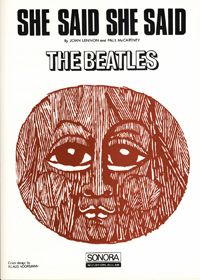
Around early 1967, Fonda crossed paths with a future Byrd, Gram Parsons, who’d just moved to Los Angeles. Peter met Gram through actor Brandon de Wilde, and suggested that Parsons’s group of the time, the International Submarine Band, supply a song for the soundtrack of the LSDploitation movie The Trip. Parsons submitted “Lazy Days,” an inappropriately rootsy tune for a film starring Fonda on an acid trip. The International Submarine Band are actually briefly seen in the movie, but the soundtrack ended up being done by Mike Bloomfield’s new group, the Electric Flag.
The Fonda-Parsons friendship did result in a recording that got put to more productive use, though few besides Parsons cultists are aware of it. In early 1967, the small Chisa label issued Fonda’s only disc, the single “November Night”/“Catch the Wind.” The B-side, of course, is a cover of the Donovan hit. Far more interesting is the A-side, as it’s an early Gram Parsons composition.
Fonda did play guitar and sing, and got some studio time with Hugh Masekela after the jazz trumpeter heard Peter perform informally at a 1966 party. The single appeared on Masekela’s own Chisa label, which he’d recently started with Stewart Levine. “November Night” features Fonda’s pleasant but nondescript voice on a pleasantly lilting, yet not incredibly memorable, song that seems like a hybrid of mild folk-rock and the kind of Latin-tempoed rock heard on early-‘60s Drifters hits. Here’s guessing the trumpet’s by Masekela himself.
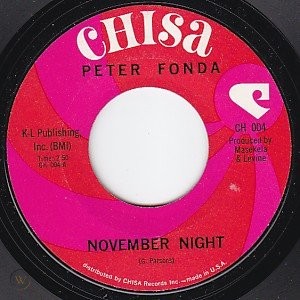
In a more noteworthy contribution to folk-rock’s annals, Masekela played trumpet on the Byrds’ 1967 hit “So You Want to Be a Rock ’n’ Roll Star,” a connection probably fostered by Masekela and the Byrds sharing management for a time. The Fonda-Byrds-Masekela love-in doesn’t end there. According to Don’t Tell Dad, Peter and Hugh recorded sixteen tracks–likely all cover versions, with some help from David Crosby and Roger McGuinn. We’ll probably never get to hear it, though, as Fonda decided against releasing the album because, again according to his autobiography, “It wasn’t there.”
Asked about “November Night” by Sid Griffin in Gram Parsons: A Music Biography, Fonda was equally unforthcoming. “I heard it and said to Gram, ‘That’s terrific,’” Peter commented. “I recorded it and Gram said how thrilled he was. He taught me how to play it and I went and practiced it and practiced it and went out and cut it.”
Fonda’s most important contribution to rock history, by far, was his role in helping to devise the soundtrack for Easy Rider. Starring Fonda and Dennis Hopper (and, in a supporting role that vaulted him to stardom, Jack Nicholson), this was the first film that used records with a purposeful and artistic intent that hadn’t been done specifically for the soundtrack. Songs by Steppenwolf, the Byrds (of course), Roger McGuinn, the Electric Prunes, Jimi Hendrix, the Band, and way-obscure bands the Holy Modal Rounders and the Fraternity of Man were selected, none of them hits except for Steppenwolf’s “Born to Be Wild.”
The tracks enhanced and complemented the on-screen action, and the soundtrack LP was even a Top Ten hit. These days the use of rock recordings on film soundtracks is commonplace, but Easy Rider was the first of its kind. Arguably, as is sometimes the case with notable firsts, it was also the best of its kind, or certainly among the very best.
As Fonda remembered in Don’t Tell Dad, “Dennis and I agreed that we should cut the film with music behind the rides to fill the track and lend emotion to the vision. We began by using music from our own record collections. It worked beyond anything we could have imagined, though some songs were finally too long. It was hard to cut out the ride with Bob Dylan’s entire ‘The Gates of Eden.’ The music and film worked together perfectly, as did many of Dennis’s lovely shots that spread the thread of the slim story. We had to keep the main story simple enough to let the allegory be felt, understood, or, at least, possible.
“Even though we had intended to ultimately use Crosby, Stills & Nash, nothing could approach the music we laid in as a temp track. Crosby and the boys recognized that when they first viewed the rough cut. Our work was cut out for us—no one had ever used already popular tunes, staples of a rapidly unfolding history, as the entire soundtrack. We had to get to so many different artists, managers, and labels for permissions that it was a logistical nightmare. Bert Schneider was the master of this most difficult bit of business, and found the challenge invigorating.
“The artists respected us, and we offered each one thousand dollars and the mechanicals (that portion of the film’s income paid to the musicians who’ve played on the soundtrack) for the right to use their music. In most instances the offer was accepted readily, much to the dismay of their agents, labels, and managers.” Incidentally, a two-CD expanded version of the soundtrack came out decades later that nearly tripled the length of the original 37-minute LP. The nineteen additional tracks on disc two feature well known late-‘60s hits by the likes of the Who, Jefferson Airplane, Moody Blues, and Chambers Brothers, and make a nice supplement, even though the directors of Easy Rider didn’t select those cuts.
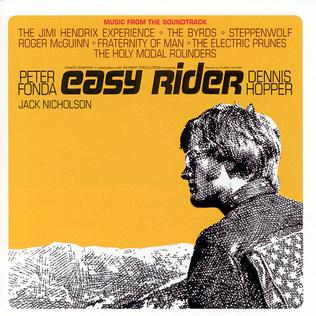
In Don’t Tell Dad, Fonda spends nearly two pages explaining how Bob Dylan and Roger McGuinn ended up co-writing “Ballad of Easy Rider,” the song that plays over the end credits. Basically, Fonda had to cajole Dylan into getting permission to use “It’s Alright Ma, I’m Only Bleeding,” and even so, was only allowed to use a portion of the lyrics in the film’s version, which was performed by McGuinn. Dylan also wanted the ending reshot so Fonda rammed his bike into the truck with riders who’d shot Hopper’s character and make the vehicle explode. After some heated discussion, Dylan “grabbed a piece of paper and wrote the lyrics to the ‘Ballad of Easy Rider’…Dylan said to have McGuinn put music to it and not use his name. McGuinn managed to put a few lines in that gave an edge to the song.”
Shortly afterward, added Fonda, “I was at party at McGuinn’s house in Malibu when a call came in for me. It was Robbie Robertson of the Band, and he’d just screened Easy Rider. I’d approached him the previous fall about doing the music for the film, but he’d made it very clear that he was not even going to talk to us, and only changed his mind, like many of the other bands, after he’d seen the movie. Now, though Robbie allowed that Dylan’s tune ‘It’s Alright Ma’ was okay, he told me that the only music in the film that was really worth anything was ‘The Weight.’ He wanted to do the entire musical score. I explained that we were marrying the sound to the film in two days, and we had a date to show the film as the official US entry at the Cannes Film Festival. Robbie didn’t get the program, and insisted again. I was pleased that he felt so strongly about the film, but there wasn’t a whole lot that could be done, and I reminded him of his refusal to even talk to us the previous fall. He still gave us permission to use ‘The Weight.’”
It’s rather amazing Fonda was even aware of the Holy Modal Rounders and Fraternity of Man, and the Rounders’ Peter Stampfel has mixed feelings about getting on the soundtrack with “Bird Song.” The track memorably accompanies the scene in which a football-helmeted Jack Nicholson takes to the road on motorcycle with Peter Fonda and Dennis Hopper. The echoed, almost incoherent stoner mumbled-sung lyrics and barroom piano fit in well with the image of both Nicholson shedding the shackles of his straight life and a generation in general having its sense of reality fractured, whether by drugs or many other factors.
For all its notoriety, it’s not a favorite of Peter Stampfel. “God, what an awful cut!” he exclaimed when I interviewed him for my book Unknown Legends of Rock ’n’ Roll. “I just heard it about a year ago, and I was incredibly embarrassed. Peter Fonda heard it on the radio–one of the few times the record was played on the radio–and thought that would be perfect for the movie. It was good luck that it got used.”
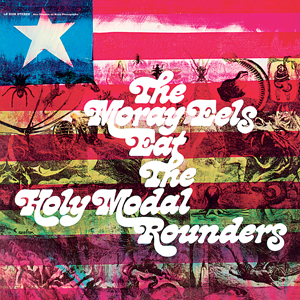
One of the most persistent urban legends in rock history is that the lead characters in Easy Rider were based on the Byrds. The cool, unflappable Fonda was Roger McGuinn; Hopper’s loudmouth who’s always threatening to cause trouble was David Crosby. Asked about this by Sid Griffin in his Gram Parsons biography, Fonda responded, “They were friends of ours certainly but we had more interest in updating a Western in Easy Rider. The characters there were more like Montgomery Clift and John Wayne. The Searchers put into today’s symbolic thing. But that doesn’t mean they were not used in the film in any way because we had the two Byrds cuts.”
Roger McGuinn, however, had a different take in Byrds: Requiem for the Timeless Vol. 1. “I told Peter, ‘Boy, I sure would have liked to have been in the movie.’ And he said: ‘You were!’ Peter and Dennis Hopper were modeling their characters after David Crosby and me. Dennis got David down…and Peter was like, ‘I trust it’ll work out all right, it’ll be cool, man.’ That’s what he meant [when he said] that I was in it. He was using me. It was a nice honor. I was really proud to have my music in it.” Added Crosby in the same book, “Dennis was me, right down to the fringed jacket and the pocket-knife. He just saw that as a good image—kind of loose and crazy, laughing, fierce at times.”
One track from the Byrds’ The Notorious Byrd Brothers (“Wasn’t Born to Follow”) was used in Easy Rider, but Fonda revealed that another cut from the same LP almost made it too. “Had ‘Draft Morning’ in the long version,” he remarked in Sid Griffin’s Gram Parsons bio. “In one of the cuts it was there. For a long time it was down to two hours and to get under two hours we cut this montage shot of them driving along the beach early in the morning with billboards behind them. ‘Draft Morning’ was going on behind this.”
As a final Fonda-folk-rock connection, Peter used guitarist Bruce Langhorne—famed for playing on records by Bob Dylan, Gordon Lightfoot, Joan Baez, Tom Rush, Richard & Mimi Fariña, Buffy Sainte-Marie, and others—to score the 1971 movie Fonda directed and starred in, The Hired Hand. The instrumental music Langhorne crafted is more designed to set the mood for an anti-Western than be something that (like the Easy Rider soundtrack) average listeners might want to play without even seeing the movie. The Hired Hand isn’t nearly as good a movie as Easy Rider either, though Fonda certainly seems to rate it at about the same level, judging from how he writes about it in Don’t Tell Dad and talks about it on the commentary track on the DVD. Langhorne’s score, however, was suitably atmospheric, and eventually issued in album form in the 21st century.
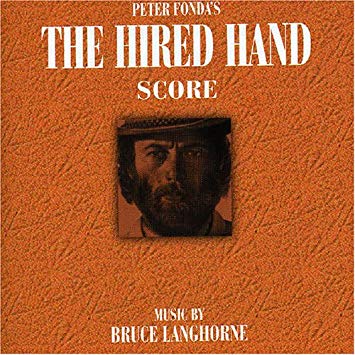
“Universal was quite nervous when I hired Bruce Langhorne to score the movie,” wrote Fonda in Don’t Tell Dad. “He had no track record in their world. In my world, he was a virtuoso on more than fifty stringed instruments, played the piano expertly, and was very capable on the drums and an array of percussion instruments. I had an entire orchestra in one man, and he was a good friend. I had his backyard shed made into a tiny recording studio.”
Fonda’s significant interactions with rock music lasted only a little more than a half decade. Easy Rider would be his most famous film by far, but he had a few memorable roles decades later, most notably in Ulee’s Gold (1997) and The Limey (1999). He barely released anything as a recording artist, but his role in rock far outweighs the modest pleasures of “November Night,” which can be heard on the 2003 Raven CD Byrd Parts 2, a collection of Byrds-related rarities. (It’s also on the box set Where The Action Is! Los Angeles Nuggets, 1965-1968.)
